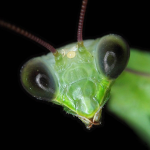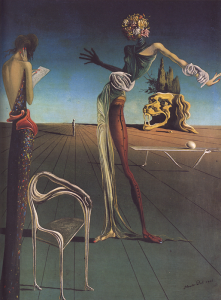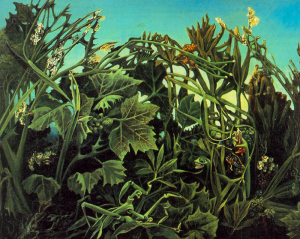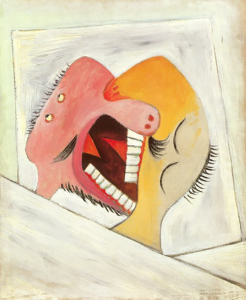by Bailey Dolenc
 Ruth Markus in her article “Surrealism’s Praying Mantis and Castrating Woman” explains the Surrealists’ demonic beliefs of women and the artworks depicting them during the late 1920s into the mid-1930s. Markus makes it clear that Surrealist painters such as Dali, Ernst, and Picasso had a disturbing complex concerning women. The woman was a symbol of sexual desire and devouring death, concepts derived from the sexual rites of the praying mantis. During copulation the female overpowers the male and decapitates him, leaving him to die. No matter the artist’s personal dilemma, the concept of the decapitating praying mantis, otherwise named the castrating woman or the vagina dentata, was central to relationships between men and females. Markus delves into indigenous beliefs ranging from the Native North American tribes to the Bushmen to further unravel and rationalize the male fear of the castrating woman.
Ruth Markus in her article “Surrealism’s Praying Mantis and Castrating Woman” explains the Surrealists’ demonic beliefs of women and the artworks depicting them during the late 1920s into the mid-1930s. Markus makes it clear that Surrealist painters such as Dali, Ernst, and Picasso had a disturbing complex concerning women. The woman was a symbol of sexual desire and devouring death, concepts derived from the sexual rites of the praying mantis. During copulation the female overpowers the male and decapitates him, leaving him to die. No matter the artist’s personal dilemma, the concept of the decapitating praying mantis, otherwise named the castrating woman or the vagina dentata, was central to relationships between men and females. Markus delves into indigenous beliefs ranging from the Native North American tribes to the Bushmen to further unravel and rationalize the male fear of the castrating woman.
 Salvador Dali’s painting A Women with a Head of Roses (1935) is a symbolic expression that further illustrates Markus’s theory with the small male figure in the background watched and dominated by a monstrous skull-shaped hill. In the foreground the bouquet-headed woman dominates the scene, making herself beautiful to elicit deceptive devouring death.
Salvador Dali’s painting A Women with a Head of Roses (1935) is a symbolic expression that further illustrates Markus’s theory with the small male figure in the background watched and dominated by a monstrous skull-shaped hill. In the foreground the bouquet-headed woman dominates the scene, making herself beautiful to elicit deceptive devouring death.
In Ernst’s painting Joy of Life (jungle) of 1936, the forests and tangled undergrowth are derived from the rich Romantic heritage in German art. Upon closer inspection, the title becomes bitterly ironic. The jungle has grown enormous, dwarfing a sculpture of a woman and an animal living together in harmony. Instead of a paradise, the scene is scary in which giant praying mantises do battle. The mantises also symbolize the fears and suppressed desires of the human mind. The female mantis overpowers the male mantis, symbolizing the metamorphic and deceptive qualities of women. Picasso’s painting The Kiss (1931), Markus adds, ultimately liberates the female from being the aggressor.
Instead of a paradise, the scene is scary in which giant praying mantises do battle. The mantises also symbolize the fears and suppressed desires of the human mind. The female mantis overpowers the male mantis, symbolizing the metamorphic and deceptive qualities of women. Picasso’s painting The Kiss (1931), Markus adds, ultimately liberates the female from being the aggressor. 
Abstract:
The iconographic praying mantis became a primary inspiration for the Surrealists, mainly due to the outcome of its bizarre mating ritual in which the female devours the male during and after copulating. Scientists such as Sigmund Freud with his writings on man’s repressed sexuality influenced the Surrealists artists. The Surrealists discovered the insect’s cannibalistic marriage a fascinating image of the hypothetical erotic viciousness lurking in the murkier recesses of the human mind. Although other insects act identically, the mantis with its extremely humanoid form is further symbolized by the scientific observations of J. H. Fabre. Fabre’s descriptions gave his insect subjects a more poetic and imaginative life.
(Jean-Henri Casimir Faber was a famous French scientist who devoted his whole life to working in entomology)
2000 – Ruth Markus, “Surrealism’s Praying Mantis and Castrating Woman”, Woman’s Art Journal, vol. 21;1, Spring/Summer, 2000; (33-39).
Dr. Ruth Markus
Education:
1985-1997 – Tel-Aviv University, History of Art
1998 – Ph.D.
Title of Doctoral Dissertation: “Linear Sculpture between the Two World Wars”, supervised by Prof. G. Ballas.
1977-1984 – Tel-Aviv University, History of Art
1984 – M. A. (with distinction)
Title of Master’s Thesis: “The Aspiration to Abolish the Mass: Towards Linear Sculpture: Cubism, Futurism, Constructivism”, supervised by Prof. M. Omer
1972-1977 – Tel-Aviv University, Theatre Studies
1977 – B. A. (with distinction)
